
CATEGORIES:
BiologyChemistryConstructionCultureEcologyEconomyElectronicsFinanceGeographyHistoryInformaticsLawMathematicsMechanicsMedicineOtherPedagogyPhilosophyPhysicsPolicyPsychologySociologySportTourism
Metropolitan Museum of Art
With more than two million works of art spanning thousands of years, the Metropolitan Museum of Art is one of the most expansive and prolific art museums in the world and it should be on everyone's New York to-do list.
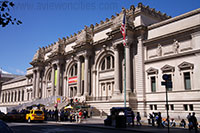
The Metropolitan Museum of Art was founded in 1870 by a group of New York citizens including not only wealthy businessmen but also artists and philosophers who wanted to share their love of art with the masses. A collection owned by railroad tycoon John Taylor Johnston seeded the museum, which quickly outgrew its original location on Fifth Avenue.
Barcelona
Sagrada Familia
 The Sagrada Familia, Antoni Gaudí's unfinished masterpiece, is one of Barcelona's most popular tourist attractions. Construction on this church will continue for at least several more decades, but it has already become Barcelona's most important landmark.
The Sagrada Familia, Antoni Gaudí's unfinished masterpiece, is one of Barcelona's most popular tourist attractions. Construction on this church will continue for at least several more decades, but it has already become Barcelona's most important landmark.
A New Church
The idea for the construction of a new church was launched by a devout organisation whose goal was to bring an end to the de-christianisation of the Barcelonese, which had started with the industrialization and increasing wealth of the city. The organisation purchased a plot of land in the new Eixample district in 1877. The architect Francisco de Paula del Villar designed a neo gothic church and led the construction which started in 1882.
La Rambla
 La Rambla is the most famous street in Barcelona. The wide boulevard connects the Plaça de Catalunya, a busy square, with the Columbus Monument and the city's waterfront.
La Rambla is the most famous street in Barcelona. The wide boulevard connects the Plaça de Catalunya, a busy square, with the Columbus Monument and the city's waterfront.
The RamblaThe often crowded street is popular with tourists and locals alike. The middle part of the Rambla is pedestrianized and bordered by trees. Kiosks, flower stalls and street artists are in abundance here. Traffic passes on either side of the pedestrian area.
 Barcelona cathedral
Barcelona cathedral
In the center of the Barri Gòtic (Gothic district), the heart of Barcelona, is the city's gothic cathedral, known as La Seu. The first stone of the current church was laid in the 13th century, but it would last until the early 20th century before the cathedral was fully completed.
La SeuThe church was named after Barcelona's patron saint Eulalia; its official name - Catedral de la Santa Creu i Santa Eulalia - is Catalan for Cathedral of the Holy Cross and Saint Eulalia. The commonly used name La Seu refers to the status of the church as the seat of the diocese.
Magic fountain
 The Magic fountain was built for the 1929 Universal Exhibition as part of a large series of cascades and fountains. During summer evenings, this large fountain is animated with colored light.
The Magic fountain was built for the 1929 Universal Exhibition as part of a large series of cascades and fountains. During summer evenings, this large fountain is animated with colored light.
Casa Batlló

The colorful Casa Batlló, a remodeled 19th century building, is one of Gaudí's many masterpieces in Barcelona. Its unique modernist interior is as fascinating as its surreal exterior
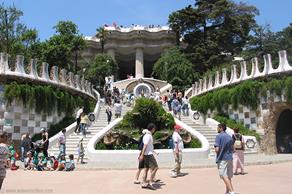
Parc Güell Staircase
Guëll Park is one of the world's most intriguing parks. The pavilions and main staircase designed by Antoni Gaudí look like they belong in some fairy tale.
Paris
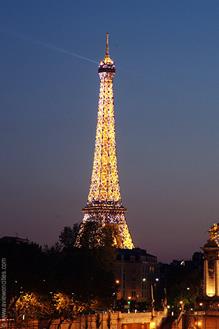 Paris, the world's most popular city destination, has plenty of must-see places but make sure you spend at least a day strolling off the beaten path, as this is the only way to discover the real Paris: a lively cosmopolitan but undeniably French city.
Paris, the world's most popular city destination, has plenty of must-see places but make sure you spend at least a day strolling off the beaten path, as this is the only way to discover the real Paris: a lively cosmopolitan but undeniably French city.
Eiffel Tower
Once the tallest structure in the world, the Eiffel Tower is probably Europe's best known landmark and Paris's most famous symbol.
You couldn't possibly visit Paris without seeing the Eiffel Tower. Even if you do not want to visit this world famous structure, you will see its top from all over Paris. The tower rises 300 meters tall (984 ft); when it was completed at the end of the 19th century it was twice as high as the Washington Monument, at the time the tallest structure in the world.
Louvre Museum
The Louvre, originally a palace but now one of the largest and most visited museums in the world, is a must-visit for anyone with a slight interest in art. Some of the museum's most famous works of art are the Mona Lisa and the Venus of Milo.
 Louvre Museum
Louvre Museum
Originally a royal palace, the Louvre became a public museum at the end of the 18th century. It is located in the 1st arrondissement,
Venus of Miloat the heart of Paris.
There are about 35.000 objects on display, spread out over three wings of the former palace. The museum has a diverse collection ranging from the antiquity up to the mid 19th century. A large part of the collection consists of European paintings and sculptures. Other rooms contain Roman, Egyptian, Greek and Oriental art. There is also a section with 'Objects d'Art', where objects such as clocks, furniture, china and tapestries are displayed.
Some of the most famous works of art in the museum are the Venus of Milo, the Nike of Samothrake, the Dying Slave by Michelangelo and of course Leonardo da Vinci's Mona Lisa.
Napoléon's Triumphal Arch
In the middle of the Place Charles de Gaulle, at the border of the 8th, 16th and 17th  arrondissement stands one of the greatest arches in history: the Arc de Triomphe (arch of triumph).
arrondissement stands one of the greatest arches in history: the Arc de Triomphe (arch of triumph).
Napoléon's Triumphal Arch
The arch was commissioned by Napoleon in 1806 to commemorate his victories, but he was ousted before the arch was completed. In fact, it wasn't completed until 1836 during the reign of Louis-Philippe. The Arc de Triomphe is engraved with names of generals who commanded French troops during Napoleon's regime.
Notre Dame
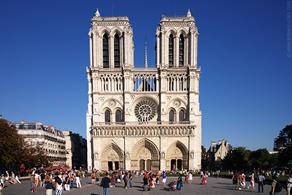 Not the largest cathedral in the world, the Notre-Dame might be the most famous of all cathedrals. The gothic masterpiece is located on the Île de la Cité, a small island in the heart of the city.
Not the largest cathedral in the world, the Notre-Dame might be the most famous of all cathedrals. The gothic masterpiece is located on the Île de la Cité, a small island in the heart of the city.
Versailles Palace
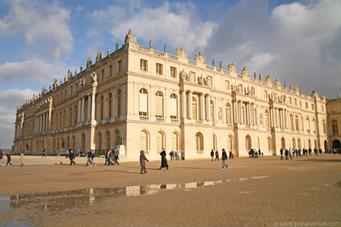 The magnificent Château de Versailles is a testimony of the Sun King's extravaganza. The Palace and its magnificent formal garden became the quintessential model for The town of Versailles sits about 20 kilometers outside of Paris. The first mention of the town and estate was in 1038, when the name appeared in a charter of the Abbey of Saint-Père de Chartres. By the end of the
The magnificent Château de Versailles is a testimony of the Sun King's extravaganza. The Palace and its magnificent formal garden became the quintessential model for The town of Versailles sits about 20 kilometers outside of Paris. The first mention of the town and estate was in 1038, when the name appeared in a charter of the Abbey of Saint-Père de Chartres. By the end of the
Versailles Palace11th century, Versailles was a country village enveloping a castle and the church of Saint-Julien, remaining prosperous until well into the 13th century. After the Hundred Years War, however, only a handful of people lived there.
palaces in Europe.

Rome
No city in the world equals the history of the Eternal City. Founded 2700 years ago, Rome long reigned as Caput Mundi, or Capital of the World
Colosseum
The Colosseum is probably the most impressive building of the Roman empire. Originally known as the Flavian Amphitheater, it was the largest building of the era.
The monumental structure has fallen into ruins, but even today it is an imposing and beautiful sight.
Trevi Fountain
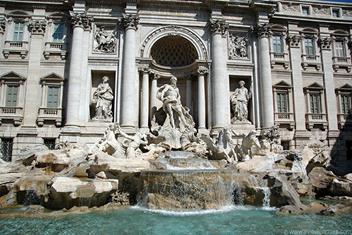 The Fontana di Trevi or Trevi Fountain is the most famous and arguably the most beautiful fountain in all of Rome. This impressive monument dominates the small Trevi square located in the Quirinale district.
The Fontana di Trevi or Trevi Fountain is the most famous and arguably the most beautiful fountain in all of Rome. This impressive monument dominates the small Trevi square located in the Quirinale district.
The water at the bottom of the fountain represents the sea. Legend has it you will return to Rome if you throw a coin into the water. You should toss it over your shoulder with your back to the fountain.
Pantheon
 Built more than 1800 years ago, the magnificent Pantheon building still stands as a reminder of the great Roman empire.
Built more than 1800 years ago, the magnificent Pantheon building still stands as a reminder of the great Roman empire.
PantheonWith its thick brick walls and large marble columns, the Pantheon makes an immediate impression on visitors. But for its time the most remarkable part of the building is the more than 43 meter high some. It was the largest dome in the world until 1436 when the Florence Cathedral was constructed.At the top of the dome is a large opening, the oculus, which was the only source of light.
The front portico has three rows of 8 columns, each one with a diameter of 1.5m. A huge bronze door gives access to the cylindrical building. Its Interior diameter equals the interior height of 43,3m.
Vatican Museums

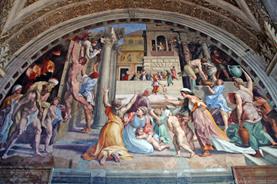
 What started as just a small collection of sculptures has, over the centuries, turned into a complex of the world's most magnificent museums featuring one of the finest collections of art on the planet.
What started as just a small collection of sculptures has, over the centuries, turned into a complex of the world's most magnificent museums featuring one of the finest collections of art on the planet.
The many museums that make up the Vatican complex are quite diverse. Nonetheless, each is interesting to explore and which you enjoy most will largely depend on your artistic preferences.
Once you've purchased your tickets for admission to the Vatican Museums, you can choose to follow one of four color-coded itineraries that range from 1.5 hours to more than 5 hours. All itineraries end in the Sistine Chapel. Even with a five-hour tour, it's impossible to see everything there is to admire, but you'll get a good overview and hit the most well-known highlights of these magnificent museums.
St. Peter's Basilica
 This great building is the center of christianity. The opulence of the building's interior bears testimony to the wealth of the catholic church in the 16th century.
This great building is the center of christianity. The opulence of the building's interior bears testimony to the wealth of the catholic church in the 16th century.
Emperor Constantine, the first Christian emperor of Rome, ordered to build a basilica on Vatican Hill. The location was symbolic: this was the place where Saint Peter, the chief apostle, was buried in 64 A.D. A small shrine already existed on the site but it was now replaced by a new building church was completed around 349 A.D.
 Prague
Prague
During the Middle Ages, Prague was the most important city in Central Europe. After emperor Charles IV had all the city gates' roofs covered with lead, Prague was dubbed the 'Golden City'. It would remain one of the most influential cities in Europe until the 20th century.
Charles Bridge
Probably the most touristy place in Prague, the Charles Bridge (Karlův Most) connects the Old Town with Lesser Town. Especially during summertime it is filled with street-painters, street-vendors and tourists. The first stone bridge over the Vltava, replacing a wooden construction, was built between 1158 and 1732 during the reign of King Vladislav I. This bridge, named Judith bridge collapsed in 1342.
Charles Bridge, named after King Charles, was 502 meters long. Resting on 16 arches it was wide enough for 4 carriages to cross at the same time and would be the only permanent link between both riversides.
Prague Castle
In spite of the many wars and fires, the Prague Castle has grown into a unique  architectural complex. It contains the gothic Saint Vitus Cathedral, a monastery, several towers and many wings of palaces. The first Prague Castle was built in the 9th century. In the 12th and 13th century the castle was fortified and expanded. Around the castle, a small community started to grow. That neighborhood, now called Lesser Town, obtained city rights in 1857. In the 14th century, under the reign of King Charles IV the whole Castle was renovated. More expansions were built by the House of Habsburg, who also redecorated large parts of the castle in a
architectural complex. It contains the gothic Saint Vitus Cathedral, a monastery, several towers and many wings of palaces. The first Prague Castle was built in the 9th century. In the 12th and 13th century the castle was fortified and expanded. Around the castle, a small community started to grow. That neighborhood, now called Lesser Town, obtained city rights in 1857. In the 14th century, under the reign of King Charles IV the whole Castle was renovated. More expansions were built by the House of Habsburg, who also redecorated large parts of the castle in a
Main entrance to the castleBaroque and neo-classicist style. After the First World War the castle became the seat of the government of Czechoslovakia and today the president of the Czech Republic still resides here.
Old Town Hall
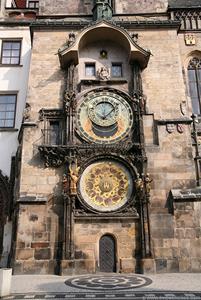

Prague's old Town Hall was built in 1364. The astronomical clock in the town hall's tower is one of the city's most popular tourist attractions. Originally the building served only as the city hall of the old town, but later became the city hall for all of Prague. It is now only used for ceremonial functions.
The first clock of the Town Hall dates back to the beginning of the 15th century. Clock maker Hanuš, who
Old Town Hall Clockperfected the construction in 1490 was - according to the legend - made blind by the city council to prevent him from making a more beautiful clock elsewhere. Most of the mechanism still used today is made by Jan Táborský between 1552 and 1572.
National Theatre
 The National Theatre, a neorenaissance structure built at the end of the 19th century, is one of Prague's most important buildings since it is seen as a symbol of Czech culture and independence.
The National Theatre, a neorenaissance structure built at the end of the 19th century, is one of Prague's most important buildings since it is seen as a symbol of Czech culture and independence.
During the mid-19th century, when Prague was still under Austrian rule, Czech citizens planned on building a theatre that was to become a symbol of Czech culture.
When the government in Vienna refused to help fund the construction of the theatre, a successful appeal was made to all Czech citizens to contribute. Many individuals were more than happy to contribute as everyone wanted to be part of this national project.Construction of the theatre started in 1865 and it was completed sixteen years later, in 1881.
Wenceslas Square

Wenceslas square was laid out in 1348 by King Charles IV. The large square, measuring 750m (0,5mi) by 60m, originally functioned as a horse market but evolved into Prague's central boulevard lined with grand turn of the century buildings. The many hotels, shops and restaurants around Wenceslas Square attract throngs of tourists and locals alike.
Many of the important historical events in Prague's recent history took place here, such as the declaration of the First Republic in 1918, National Museum the protests against the Soviet occupation in 1969 and the protest march in 1989 which led to the Velvet Revolution and the end of the Communist era.
Date: 2015-12-11; view: 1790
| <== previous page | | | next page ==> |
| Ex.7. Read the text and answer the question after it. | | | Zabytki w Warszawie |